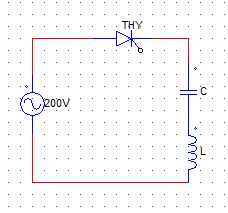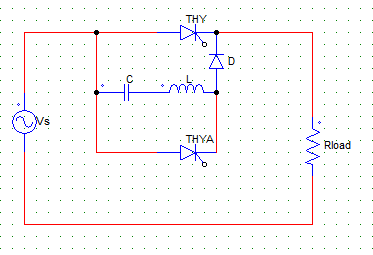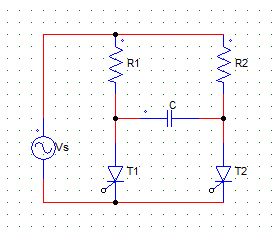This set of Power Electronics Questions & Answers for entrance exams focuses on “SCR Commutation Techniques-2”.
1. For the circuit shown in the figure below,

C = 4 pF
L = 16 μH
Vs = 200V
The capacitor voltage after the SCR is self commutated is
a) -100 V
b) -200 V
c) -400 V
d) 0 V
View Answer
Explanation: It is simply the negative of Vs as it is a series circuit & after turn off the whole voltage appears across the thyristor.
2. For the circuit shown below,

The maximum value of current through thyristors T1 & TA can be given by
a) Vs/R, Vs√C/L
b) Vs √C/L, Vs/R
c) Vs/R + LC, Vs
d) Vs/LC, Vs/R
View Answer
Explanation: I1 = (Vs/R)
T2 = (Vs√C/L).
3. For the circuit shown in the figure below,

C = 4 pF
L = 16 μH
Vs = 200 V
The peak thyristor current is
a) 800 A
b) 400 A
c) 100 A
d) 50 A
View Answer
Explanation: The peak SCR current is Vs/2.
4. For the circuit shown in the figure below, ___ type of commutation would take place for the SCR (THY1)

a) line
b) load
c) forced
d) external-pulse
View Answer
Explanation: The given figure is that of a class B commutation or resonant-pulse commutation, which is a type of forced commutation technique.
5. For the circuit shown in the figure below,

R1 = 50 Ω, R2 = 100 Ω, Vs = 100 V. At the time of turn-on of the SCR, initial thyristor current is
a) 0 A
b) 10 A
c) 5 A
d) 3.5 A
View Answer
Explanation: Io = Vs x [(2/R1)+(1/R2)].
6. Natural commutation of an SCR takes place when
a) voltage across the device becomes negative
b) voltage across the device becomes positive
c) gate current becomes zero
d) anode current becomes zero
View Answer
Explanation: Anode current (load current) becomes zero and turns off the device, hence the name line commutation.
7. ___________ commutation is usually used in phase-controlled rectifiers
a) line
b) load
c) forced
d) external-pulse
View Answer
Explanation: Line commuataion is used in converters.
8. Parallel-capacitor commutation is
a) line commutation
b) load commutation
c) forced commutation
d) external-pulse commutation
View Answer
Explanation: Parallel capacitor is another name for forced commutation.
9. Class E commutation is a/an
a) line commutation technique
b) load commutation technique
c) forced commutation technique
d) external-pulse commutation technique
View Answer
Explanation: As an external source is used it is a external-pulse commutation technique.
10. Below is the circuit of a resonant-pulse commutation, the maximum voltage to which the capacitor C charges is

a) Vs
b) Vs/2
c) 2
d) √2Vs
View Answer
Explanation: The capacitor charges from 0 to Vs with the right side plate positive.
Sanfoundry Global Education & Learning Series – Power Electronics.
To practice all areas of Power Electronics for entrance exams, here is complete set of 1000+ Multiple Choice Questions and Answers.
If you find a mistake in question / option / answer, kindly take a screenshot and email to [email protected]
